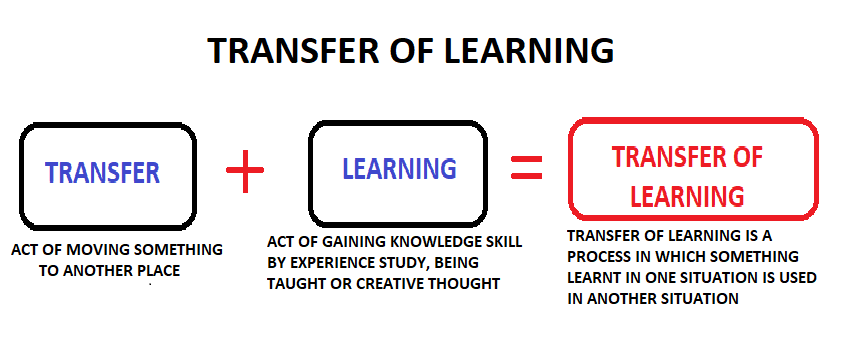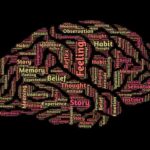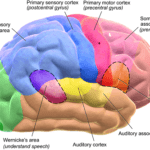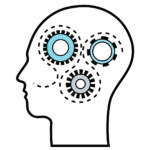TYPES OF TRANSFER OF LEARNING
Types of transfer of learning When a person uses his past experiences to do something new, we call it transfer of learning. It is not certain that transfer is to take place from each and every situation to the other. Further, it is also not certain that learning in one situation will always help positivity in learning in another situation. It may even adversely affect the subsequent learning.
Definition of transfer of learning
According to CROW AND CROW– The carryover of the habit of thinking feeling or working of knowledge or of skills from one learning area to another is usually referred to as transfer of learning.
According to PETERSON– The transfer of learning is a generalization, for it is an extension of an idea to a new field.


The transfer of learning can be classified into three types:-
POSITIVE TRANSFER OF LEARNING
In this type of transfer of learning, the acquisition of a previous skill facilitates the acquisition of another skill. This usually happens when the two abilities in question are similar in some way. In the case of positive transfer, the effect of earlier learning is suitable or beneficial and enhances subsequent learning. If an individual makes use of previous experience or knowledge in responding to the new stimulus in some way, it amounts to a positive transfer of training.
For example, when a player learns to play basketball, it will be easier for him to learn to play handball, both being ball games. The skill learned in one such game, for example, dribbling, will facilitate the learning of such skill in the other game.
For example, The same is the case of learning some languages also. Knowledge of Latin has a positive transfer effect while learning English or vice versa. Similarly, knowledge of mathematics accelerates the learning of physics and accountancy.
The amount of positive transfer of learning depends on the similarities of the elements, the amount of overlearning of previous skills, the intelligence of the learner, and the assistance given by the teacher or the coach. Positive transfer of learning also occurs due to the similarity of content, the similarity of technique, or the similarity of principles involved therein. When two tasks are similar part-whole relationships, the transfer is certainly bound to be positive or beneficial.
NEGATIVE TRANSFER OF LEARNING
The negative transfer of learning is just Opposite to the positive transfer of learning, this is a type of learning in which prior experience impacts negatively on the new one. Or we can say, in case the acquisition of a particular skill interferes with the learning of a subsequent skill, it is known as a negative transfer of training.
If the learner is to make a new response to an old stimulus, the result would be a negative transfer. When the previous learning is a handicap, or it inhibits the acquisition of some skill in the subsequent situation, it will be a negative transfer of learning. If the new response is practiced in a situation that in the past required a different response, the transfer will have an unfavorable effect on the skill in question. It has subsequent learning of the correct skills. It is so because the habit pattern from one situation hampers or inhibits learning in another situation.
For example, when a table tennis player attempts to learn strokes involved in lawn tennis, his previous acquisition of wrist movements is likely to interfere with lawn tennis stroke where wrist movement is generally avoided. Here stimulus is the same, a racket, but the new stroke, a new response, is different from the old response.
It has been found that unsuccessful or unhappy experiences also inhibit the effort to find out a solution to a new problem in a setting similar to the one previously encountered. Normally, negative transfer, unlike the positive transfer of training, tends to be transitory and rarely does its interference last long.
ZERO TRANSFER OF LEARNING
If the new skill to be learned is totally unrelated to the previous skill, the transfer of training will neither be positive nor negative i.e. no transfer of training will take place, or the effect will be entirely neutral. Such a situation is referred to as zero transfer of learning.
When the acquisition of a skill in one task neither facilitates nor discourages the learning of another skill, it can be termed as zero transfer of training,
For example, having learned BASKETBALL will probably have no effect on learning SWIMMING strokes.
It has been seen that in certain learning situations, the previous learning may partly help and partly interfere with the learning in the new situation i.e. the transfer may be partly positive and partly negative.
For example, there may be some positive transfer between the strokes of badminton and tennis as they both are fundamental striking skills but in the case of tennis, the stroke is to be executed with a straight arm whereas, in badminton stroke, wrist action is involved i.e. there will be negative transfer.
Some other types of transfer of learning
Proactive Transfer
- A skill mastered in the past has an impact on a skill being learned now or in the future.
Retroactive Transfer
- A previously learned skill is impacted by learning a new talent or skill.
Bilateral Transfer
- When learning a skill is transferred from one limb to the other, as when a basketball player learns to pass with their left hand after first acquiring this talent with their right hand.
Six different types of skill transfer have been recognized:
- Transfer of skill sets, like in all racket sports
- Transferring abilities acquired during training to a competitive setting is known as “practice to performance.”
- Skills and abilities that are related: balance required for a successful gymnastics landing
- Limb to limb (bilateral) – using either the right or left foot to make the basket.
- Basketball defensive techniques are comparable to handball’s in terms of skill.
- Learning phases: After acquiring knowledge in the cognitive phase, knowledge will be expanded upon in the associative phase.





